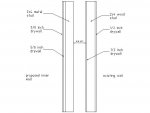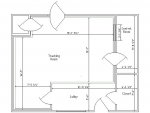AlChuck
Well-known member
For Musicians, Solid Walls Make Good Neighbors
February 21, 2004
By SABRINA TAVERNISE
Jay Braun, a guitarist for a New York City rock band called the Negatones, is well versed in the science of soundproofing.
"Sheetrock, sound board and plywood, over and over," said Mr. Braun, a fast-talking 32-year-old who has put up soundproofing in two New York City living spaces. "We really did want to be good neighbors."
Although musicians began recording in their homes as early as the 1970's, the migration away from professional studios to homes expanded in the 1980's, as drum machines and multitrack tape recorders came into widespread use. Now that computers and recording software are household items - new Apple computers come with a program called GarageBand - recording at home, for musicians, has become routine.
"It's becoming harder and harder to find people who do not have their own home studio," said Alan Fierstein, a SoHo-based acoustic consultant, whose own professional studio, Sorcerer Sound, recently closed.
"Twenty years ago, a studio was the only place you could make music," said Russell Simins, drummer for the Jon Spencer Blues Explosion, a New York City band.
"Ten years ago that was less true," he said. "Now studios are being avoided. People have computers. They sit at home."
But with home studios came the noise. And the efforts to contain it.
"It's the neighbors that create the soundproofing equation," said Gary Silver, a sound designer who has been soundproofing homes and professional studios since 1984. "New York being what it is, that really makes it a problem."
For Michael Mehler, who lives directly below a home studio in a building on the Lower East Side, the most frustrating thing about the musician upstairs is his choice of instrument. "Jumping up and down with the electric guitar is different than playing Bach," Mr. Mehler said on a recent Saturday. "It's not like he's a violinist."
Mr. Mehler added that the musician "could do it with headphones."
That is precisely the advice offered by Richard Murdock, a property manager in Manhattan, who has had to handle complaints about a tenant with a studio in a Lower East Side building.
"That boom boom boom, and the rattling of the dishes," he said. "Most of these old tenement buildings are not steel and concrete. Playing live music in an apartment, it's impossible not to encroach upon your neighbors."
Muffling music is often harder than it seems. The first mistake, Mr. Silver said, is the assumption that sound can be trapped in a room by putting up some carpets. "I constantly have people talking about foam, fabric and
egg cartons," he said. "You need mass. Sheetrock, concrete, wood. Expensive, heavy things have to be built."
Mr. Braun, like most people, began on the low end of the learning curve.
His first attempt at soundproofing came in 1996, when the band rented part of an artist's loft in Williamsburg. The band members marched to a Home Depot and bought plywood, and slabs of Sheetrock and layers of soundboard.
"We thought we were so sophisticated," recalled Mr. Braun, dressed in a rumpled suit jacket and sneakers on a recent Thursday afternoon. "We were all high-fiving each other up to the time we brought in the bass and the drum set."
But the new walls had a puzzling effect. Instead of sounding softer, Mr. Braun said, the music "seemed to have gotten louder."
It was a defining moment. Mr. Braun realized that "there is, in fact, a reason for science."
The band left the building. For a while, they rented part of a woodworking studio, where they played among table saws. Meanwhile his peers were playing in rented Manhattan Mini Storage spaces.
Mr. Braun began wrestling with physics in a basement space on Stanton Street. He hired a carpenter to design an elaborate semi-suspended ceiling in the space, which was not supposed to be lived in, but often was - several of the band members called it home from time to time. The ceiling was made of five layers of material: particleboard; two
layers of sound board, which functions as a thick cushion; plywood; and Sheetrock.
"Sound is like water," said Mr. Braun, flanked by a laptop computer and a console in the band's newly rented recording space in Williamsburg, Brooklyn. "If you drill one hole in the wall, the sound will leak right through."
Month after month the band added new layers. They removed a water pipe that carried sound into a neighbor's apartment. They spent $20,000, by Mr. Braun's calculation. "We became handymen," he said.
They recorded albums in the space in the meantime, not bothering to wait for perfection. But the noise and activity was eventually noticed by city inspectors, and they were given two months to leave.
Mr. Fierstein said that many penny-pinching musicians skipped soundproofing altogether. Instead, bathrooms and closets become recording spaces.
"People can't afford soundproofing, but they have to have the ability to record a singer," Mr. Fierstein said. "The bathroom is the closest thing to a concert hall."
As more musicians stay at home to make music, professional recording studios have suffered. Bill Tesar, the owner of the Toy Specialists, a large sound equipment rental company, said improved technology for home recording and reduced budgets from record companies have caused business with studios to decline over the past three years. His
company, in business since 1983, closed last week. "I'd say more than 60 percent of the midsize recording studios that were in business five years ago are now out of business," Mr. Tesar said. "That's not an inflated guess. There were literally hundreds of them in the New York metro area. Now, if there are 40 or 50, that's a lot."
Even freelancers are worried. Adam Kendall, who plays in an electronic music group and also records bands out of his apartment in Park Slope, Brooklyn, says he is concerned that the amount of work he's had the past several years will decline.
"I'm the person big studios hate," he said. But he added that Apple's release of GarageBand "is my karmic return."
He added, "I gave up hope for making money recording music."
Some musicians said home studios and computer equipment were making recording quieter. Richard Bernstein, lead guitarist for Rammstein, a German heavy metal group, said the recording process was less collaborative now, more a solitary plinking on a computer keyboard than a group playing effort.
"You don't have to listen loud anymore," said Mr. Bernstein, whose concerts feature feats of pyrotechnics.
Music today is "everyone is cooking in his own kitchen by himself," he said, in his home studio on the first floor of a former firehouse on Lafayette Street in Manhattan. "It used to be five guys playing together, but that doesn't happen as much anymore."
"You can do everything without other people's presence," Mr. Bernstein said.
Besides, says Mr. Kendall, "am I really making more noise than a guy on Sunday who is watching an Arnold Schwarzenegger movie in surround-sound?"
There are those musicians for whom such questions are not rhetorical. Howie Statland, the musician who lives upstairs from Mr. Mehler, said he could not afford soundproofing and, even if he could, his neighbors' blaring music and yelling children would give him the right to make noise
freely. He has a guitar amplifier in his bedroom and plays often. Drums were his one concession.
"The guy downstairs gets upset when I put the guitar too loud," Mr. Statland said.
A basic philosophy, however, prevails. "I've had people yell, `Shut up,' but they're out there, and I'm in here. What are they going to do?"
Not everyone records at home all the time. Many musicians still use large studios for much of their final products.
"People who are making big money music are still going to the two or three big studios in Manhattan," said Mr. Simins, whose own small recording studio is not in his home. "Britney Spears doesn't sit at home in front of her computer."
As for Mr. Braun, he sums up his hard-earned wisdom in soundproofing succinctly. "You can follow the rules note for note, but if you have an old lady sleeping downstairs, that's it," he said.
Recognizing that there are advantages to a separate studio, his band rented one in Williamsburg last year. The main criteria: no soundproofing required. The studio is in an industrial zone on a corner, just beneath the Williamsburg Bridge.
http://www.nytimes.com/2004/02/21/nyregion/21NOIS.html?ex=1078388012&ei=1&en=7f9ca1022384eccc
February 21, 2004
By SABRINA TAVERNISE
Jay Braun, a guitarist for a New York City rock band called the Negatones, is well versed in the science of soundproofing.
"Sheetrock, sound board and plywood, over and over," said Mr. Braun, a fast-talking 32-year-old who has put up soundproofing in two New York City living spaces. "We really did want to be good neighbors."
Although musicians began recording in their homes as early as the 1970's, the migration away from professional studios to homes expanded in the 1980's, as drum machines and multitrack tape recorders came into widespread use. Now that computers and recording software are household items - new Apple computers come with a program called GarageBand - recording at home, for musicians, has become routine.
"It's becoming harder and harder to find people who do not have their own home studio," said Alan Fierstein, a SoHo-based acoustic consultant, whose own professional studio, Sorcerer Sound, recently closed.
"Twenty years ago, a studio was the only place you could make music," said Russell Simins, drummer for the Jon Spencer Blues Explosion, a New York City band.
"Ten years ago that was less true," he said. "Now studios are being avoided. People have computers. They sit at home."
But with home studios came the noise. And the efforts to contain it.
"It's the neighbors that create the soundproofing equation," said Gary Silver, a sound designer who has been soundproofing homes and professional studios since 1984. "New York being what it is, that really makes it a problem."
For Michael Mehler, who lives directly below a home studio in a building on the Lower East Side, the most frustrating thing about the musician upstairs is his choice of instrument. "Jumping up and down with the electric guitar is different than playing Bach," Mr. Mehler said on a recent Saturday. "It's not like he's a violinist."
Mr. Mehler added that the musician "could do it with headphones."
That is precisely the advice offered by Richard Murdock, a property manager in Manhattan, who has had to handle complaints about a tenant with a studio in a Lower East Side building.
"That boom boom boom, and the rattling of the dishes," he said. "Most of these old tenement buildings are not steel and concrete. Playing live music in an apartment, it's impossible not to encroach upon your neighbors."
Muffling music is often harder than it seems. The first mistake, Mr. Silver said, is the assumption that sound can be trapped in a room by putting up some carpets. "I constantly have people talking about foam, fabric and
egg cartons," he said. "You need mass. Sheetrock, concrete, wood. Expensive, heavy things have to be built."
Mr. Braun, like most people, began on the low end of the learning curve.
His first attempt at soundproofing came in 1996, when the band rented part of an artist's loft in Williamsburg. The band members marched to a Home Depot and bought plywood, and slabs of Sheetrock and layers of soundboard.
"We thought we were so sophisticated," recalled Mr. Braun, dressed in a rumpled suit jacket and sneakers on a recent Thursday afternoon. "We were all high-fiving each other up to the time we brought in the bass and the drum set."
But the new walls had a puzzling effect. Instead of sounding softer, Mr. Braun said, the music "seemed to have gotten louder."
It was a defining moment. Mr. Braun realized that "there is, in fact, a reason for science."
The band left the building. For a while, they rented part of a woodworking studio, where they played among table saws. Meanwhile his peers were playing in rented Manhattan Mini Storage spaces.
Mr. Braun began wrestling with physics in a basement space on Stanton Street. He hired a carpenter to design an elaborate semi-suspended ceiling in the space, which was not supposed to be lived in, but often was - several of the band members called it home from time to time. The ceiling was made of five layers of material: particleboard; two
layers of sound board, which functions as a thick cushion; plywood; and Sheetrock.
"Sound is like water," said Mr. Braun, flanked by a laptop computer and a console in the band's newly rented recording space in Williamsburg, Brooklyn. "If you drill one hole in the wall, the sound will leak right through."
Month after month the band added new layers. They removed a water pipe that carried sound into a neighbor's apartment. They spent $20,000, by Mr. Braun's calculation. "We became handymen," he said.
They recorded albums in the space in the meantime, not bothering to wait for perfection. But the noise and activity was eventually noticed by city inspectors, and they were given two months to leave.
Mr. Fierstein said that many penny-pinching musicians skipped soundproofing altogether. Instead, bathrooms and closets become recording spaces.
"People can't afford soundproofing, but they have to have the ability to record a singer," Mr. Fierstein said. "The bathroom is the closest thing to a concert hall."
As more musicians stay at home to make music, professional recording studios have suffered. Bill Tesar, the owner of the Toy Specialists, a large sound equipment rental company, said improved technology for home recording and reduced budgets from record companies have caused business with studios to decline over the past three years. His
company, in business since 1983, closed last week. "I'd say more than 60 percent of the midsize recording studios that were in business five years ago are now out of business," Mr. Tesar said. "That's not an inflated guess. There were literally hundreds of them in the New York metro area. Now, if there are 40 or 50, that's a lot."
Even freelancers are worried. Adam Kendall, who plays in an electronic music group and also records bands out of his apartment in Park Slope, Brooklyn, says he is concerned that the amount of work he's had the past several years will decline.
"I'm the person big studios hate," he said. But he added that Apple's release of GarageBand "is my karmic return."
He added, "I gave up hope for making money recording music."
Some musicians said home studios and computer equipment were making recording quieter. Richard Bernstein, lead guitarist for Rammstein, a German heavy metal group, said the recording process was less collaborative now, more a solitary plinking on a computer keyboard than a group playing effort.
"You don't have to listen loud anymore," said Mr. Bernstein, whose concerts feature feats of pyrotechnics.
Music today is "everyone is cooking in his own kitchen by himself," he said, in his home studio on the first floor of a former firehouse on Lafayette Street in Manhattan. "It used to be five guys playing together, but that doesn't happen as much anymore."
"You can do everything without other people's presence," Mr. Bernstein said.
Besides, says Mr. Kendall, "am I really making more noise than a guy on Sunday who is watching an Arnold Schwarzenegger movie in surround-sound?"
There are those musicians for whom such questions are not rhetorical. Howie Statland, the musician who lives upstairs from Mr. Mehler, said he could not afford soundproofing and, even if he could, his neighbors' blaring music and yelling children would give him the right to make noise
freely. He has a guitar amplifier in his bedroom and plays often. Drums were his one concession.
"The guy downstairs gets upset when I put the guitar too loud," Mr. Statland said.
A basic philosophy, however, prevails. "I've had people yell, `Shut up,' but they're out there, and I'm in here. What are they going to do?"
Not everyone records at home all the time. Many musicians still use large studios for much of their final products.
"People who are making big money music are still going to the two or three big studios in Manhattan," said Mr. Simins, whose own small recording studio is not in his home. "Britney Spears doesn't sit at home in front of her computer."
As for Mr. Braun, he sums up his hard-earned wisdom in soundproofing succinctly. "You can follow the rules note for note, but if you have an old lady sleeping downstairs, that's it," he said.
Recognizing that there are advantages to a separate studio, his band rented one in Williamsburg last year. The main criteria: no soundproofing required. The studio is in an industrial zone on a corner, just beneath the Williamsburg Bridge.
http://www.nytimes.com/2004/02/21/nyregion/21NOIS.html?ex=1078388012&ei=1&en=7f9ca1022384eccc



